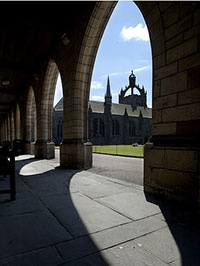
William Elphinstone established King's College to train doctors, teachers and clergy for the communities of northern Scotland, and lawyers and administrators to serve the Scottish Crown. Much of the King's College still remains today, as do the traditions which the Bishop began.
King's College opened with 36 staff and students, and embraced all the known branches of learning: arts, theology, canon and civil law. In 1497 it was first in the English-speaking world to create a chair of medicine. Elphinstone's college looked outward to Europe and beyond, taking the great European universities of Paris and Bologna as its model.
Uniting the Rivals
In 1593, a second, Post-Reformation University, was founded in the heart of the New Town of Aberdeen by George Keith, fourth Earl Marischal. King's College and Marischal College were united to form the modern University of Aberdeen in 1860. At first, arts and divinity were taught at King's and law and medicine at Marischal. A separate science faculty - also at Marischal - was established in 1892. All faculties were opened to women in 1892, and in 1894 the first 20 matriculated female students began their studies. Four women graduated in arts in 1898, and by the following year, women made up a quarter of the faculty.
Into our Sixth Century
Throughout the 20th century Aberdeen has consistently increased student recruitment, which now stands at over 15,000. In recent years picturesque and historic Old Aberdeen, home of Bishop Elphinstone's original foundation, has again become the main campus site.
The University has also invested heavily in medical research, where time and again University staff have demonstrated their skills as world leaders in their field. The Institute of Medical Sciences, completed in 2002, was designed to provide state-of-the-art facilities for medical researchers and their students. This was followed in 2007 by the Health Sciences Building. The Foresterhill campus is now one of Europe's major biomedical research centres. The Suttie Centre for Teaching and Learning in Healthcare, a £20m healthcare training facility, opened in 2009.
Investing in our Future
2012 saw the opening of the £57 million Sir Duncan Rice Library in Old Aberdeen, a great modern building to match the splendour of the University's 500 year old campus.
The fact that the University has become what it is owes much to the determination and vision of a handful of visionaries and pioneers, including a distinguished list of scholars who in their own unique ways, helped to shape the University into the world-class institution we have today.
Timeline
- 1495
-
The University is founded by William Elphinstone, Bishop of Aberdeen and Chancellor of Scotland, with the ambition “...to found a university, which would be open to all and dedicated to the pursuit of truth in the service of others”. The University of Aberdeen becomes the UK's fifth university.
- 1505
-
The University opens with 36 staff and students, having eight years earlier boasted the first chair of medicine in the English-speaking world. The University embraces all the known branches of learning - arts, theology, and canon and civil law.
- 1860
-
King's College and Marischal College merge to form the University of Aberdeen. Initially, arts and divinity are taught at King's and law and medicine at Marischal.
- 1892
-
The University opens all Faculties to women and in 1894 the first 20 matriculated female students begin their studies. Four women graduate in arts in 1898; by the following year, women make up a quarter of the Faculty.
- 1921
-
The first of five Nobel Prizes is awarded for work begun or carried out at the University. Inventions include the life-saving drug insulin and the development of Magnetic Resonance Imaging (MRI).
- 1999
-
The University launches its ambitious fundraising campaign with the aim of raising £150 million to mark the start of the University's sixth century of existence. In 2004 this continues with a £9 million investment programme to appoint exceptional academics to the University, thereby strengthening the intellectual capital of the institution.
- 2003
-
The Institute of Medical Sciences at the Foresterhill campus is completed. The custom-built Institute provides state-of-the-art facilities for medical researchers and their students. Six years on, the Suttie Centre, the new training centre at the heart of the academic and hospital campus opens for the modern teaching of anatomy linked to other medically-related sciences.
- 2005-6
-
In 2005 the University celebrates 500 years of teaching and learning and The Old Town House on King's College campus is transformed to become a visitor gateway to the University and Old Aberdeen.
2006 sees the enhancement of student facilities on campus. 'The Hub', an £8 million renovation project, boasts a superb range of services, including dining, retail and drop-in centres for the student community.
- 2009
-
The University's first class sports and leisure facilities are further boosted by the opening of the newly developed Aberdeen Sports Village, a £28 million Olympic standard sports centre highlighting the University's commitment to sustaining sporting excellence.
- 2011
-
The University's brand new £57 million Sir Duncan Rice Library opens to students and the wider community. The library is established as a major intellectual and cultural learning centre for students in the 21st century.
- 2014
-
The new Aquatics Centre opened in May 2014. The centre provides a first class training and competition venue for elite athletes and offers a community facility that encourages participation in water-based activities at all ages and abilities. The world-class facility includes a 50-metre, 10 lane Olympic-standard swimming pool, an international-standard diving pool with moveable floor and a health suite, and is located adjacent to Aberdeen Sports Village.
